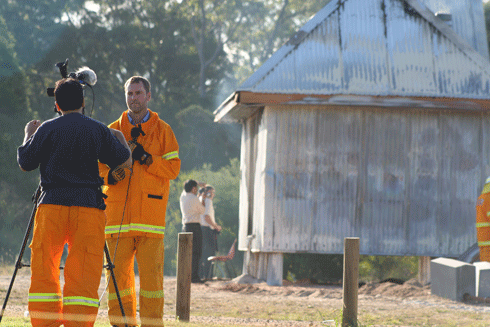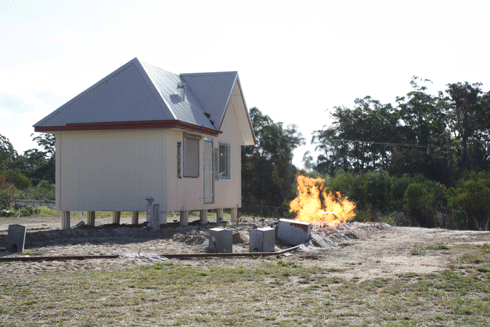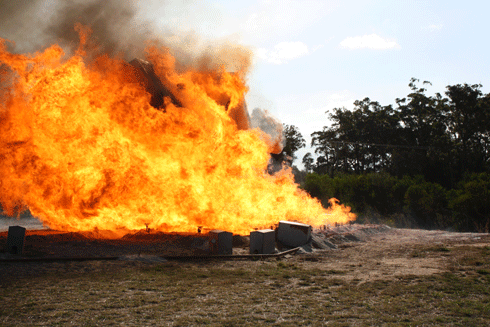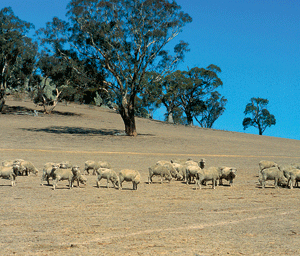
|
Published: 21 November 2011
Balancing fire-risk at the urban fringe
After heavy spring rains in south-eastern Australia, fire agencies are warning of danger ahead as hot, dry weather turns lush grass into fuel. How can we better equip at-risk homes – old and new – to withstand bushfires? ECOS put the question to CSIRO scientist Justin Leonard, who studies the impact of bushfires on homes and urban infrastructure.

|
|
Justin Leonard fronts the media after the CSIRO/NASH house-burning experiment carried out at the NSW Rural Fire Brigade’s testing facility, Mogo, NSW. Credit:
David Bruce, Bushfire CRC
|
Justin Leonard’s home happens to be situated in an area bordering national park at the foot of Melbourne’s Dandenong Ranges – where 27 people died during Victoria’s 1983 Ash Wednesday fires, and which narrowly escaped the worst of the 2009 Black Saturday fires.
Like many in the area, his house was built more than a decade ago, when fire-resistant design and materials were still unheard of.
Thanks to Justin and his team at CSIRO, we now have a much better idea of how to fireproof homes and urban infrastructure. Their research, including ambitious experiments carried out in unique facilities using real fire, has been contributing to new design and materials guidelines for homes in bushfire-prone areas – especially those, like Justin’s, that are close to bushland.
In 2010, the team partnered with the National Association of Steel Framed Housing (NASH) to build a steel-framed house. Apart from the steel framing, the house was largely built from non-combustible materials – exterior cladding, plasterboard internal wall and ceiling lining, cement sheet flooring, fibreglass batts and foil-backed blanket insulation.
‘The aim was to design and test a cheap conventional house structure that used the entire building envelope to protect the occupants, rather than relying on the building’s external cladding as the only defence,’ says Justin, who has investigated every major fire in eastern Australia since the Sydney fires of 1994, where over 200 houses were lost.

|
|
The steel framed house was largely built from non-combustible material and air gaps sealed on all outside surfaces, which helped prevent ember entry. Credit:
CSIRO
|
The researchers subjected the house to a simulated, high-intensity bushfire. From sensors strategically placed around the building, the researchers gathered a mass of valuable data on the building’s performance, before, during and after the fire.
The data and outcome proved that appropriately built steel-framed structures can act as a protective fire-resistant shell in the event of fire. The walls, floor and roof of the experimental house prevented flame and ember entry, even though the structure was engulfed by fire during the course of the experiment.

|
|
The NASH test house fully engulfed by flames at the height of the experiment. Credit:
CSIRO
|
Some of the rebuilding that has occurred in areas affected by the Black Saturday fires is a cause of some concern to Justin and others involved in the 2009 Victoria Bushfires Royal Commission, which was set up in the wake of the disaster.
‘People who have lost their houses in areas not subject to bushfire regulations seem to have gone back to their old ways, building conventional structures,’ he says.
‘I’ve seen only isolated examples of people stepping up to define the risk and manage it properly.
‘In areas where bushfire regulation has an effect on the way people rebuild, I would strongly encourage them to make the effort to understand bushfire behaviour, and the range of issues that the regulations do not cover. Ongoing maintenance and the risk posed by neighbouring houses, fences and vehicles are an obvious place to start.’
While preparing property is an important part of bushfire defence, having a thoroughly thought-out bushfire response plan is even more critical.
‘Different states have different policies in building, urban planning, warning and evacuation,’ says Justin. ‘Generally, people living in bushfire-prone areas need a robust plan that caters for all circumstances, including what level of forecasted severe weather would trigger them to leave early.
‘They also need to identify the point at which it may become too risky to leave due to a lack of confidence that they will safely reach an area of low risk.’
As a bushfire researcher, Justin has an advantage over his neighbours in weighing up the risks. For example, he knows that a fire-front approaching his house from the national park will be slower and less intense because of the building’s downhill location. But that’s just one consideration among many.
‘Like many other homeowners, I have a long list of things I’d like to do to my house and surroundings to make them safer and easier to defend in a bushfire,’ says Justin.
‘Importantly the list is prioritised – the items highest on my list deal with the most likely cause of house ignition for this situation.’
Ember ignition and entry was an obvious place to start. ‘Installing ember-proof gutter guard and using a non-flammable insulation in my roof space were some of the first things in my list.
‘Virtually everything on my list achieves multiple benefits – the gutter guard has been great in eliminating seasonal gutter cleaning, and the insulation has had a major impact on my energy bills.’
Although he’s only ticked off a few items on his list, Justin says he feels comfortable about being able to defend his house in a fire of similar intensity to those that have been through the Dandenong Ranges area in the past.
‘However I am wary of the fact that under really severe fire weather conditions, wind damage, flying debris and extreme fire behaviour would make it too risky. So I would leave the house on “code red” days” he adds.

|
|
Researchers from CSIRO and the Bushfire CRC documenting the impacts of Black Saturday in 2009. Credit:
Nick Pitsas/CSIRO
|
The top risk reduction factor that Justin and fire authorities point to is the proximity of a property to bushland. More than 500 000 homes in Australia have been built within 100 metres of bush, a high-risk zone where 89–90 per cent of homes are lost during fires.
Are this year’s high fuel levels along the east coast an added cause for concern?
‘From an individual property perspective, grass and shrub fuels are a major threat when they are near or adjacent to the home, but become much less important as you move 50–100 metres away from the property,’ says Justin.
‘This year’s fuel levels are certainly a concern and are likely to make it more difficult for the fire agencies to manage fire in the landscape.
‘However, for a bushfire event to get severe enough to threaten large numbers of people and homes, you also need sustained hot dry conditions to dry out the landscape (including the houses), then a day of severe fire weather to support a major fire “run”.
‘The warning systems in place around Australia are designed to identify these factors.’
Note: For a recent perspective on fuel-reduction burning, see the new CSIRO Publishing book, Burning Issues: Sustainability and Management of Australia’s Southern Forests by Mark Adams & Peter Attiwill.



